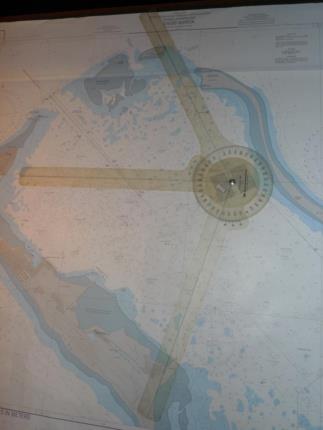
NavList:
A Community Devoted to the Preservation and Practice of Celestial Navigation and Other Methods of Traditional Wayfinding
3-armed protractor
From: Jeremy C
Date: 2009 Jul 26, 10:14 EDT
--~--~---------~--~----~------------~-------~--~----~
NavList message boards: www.navlist.net
Or post by email to: NavList@navlist.net
To , email NavList-@navlist.net
-~----------~----~----~----~------~----~------~--~---
From: Jeremy C
Date: 2009 Jul 26, 10:14 EDT
A while back there was some discussion about the use of a three-armed
protractor for navigation. Here is a case where it was used in the real
world.
We are currently anchored in the lagoon of the island of Diego
Garcia. The captain is not happy with reliance on electronic navigation so
is requiring the mates on watch to provide visual bearings as well as GPS/ECDIS
fixes and RADAR.
There are two ways to use the 3 armed protractor for anchor position.
Since we are equipped with Alidades and gyro repeaters, I find it easier to
shoot three bearing with good spread on the gyro compass and calculate the
differences in gyro degrees between the three. To this end I set the
main arm of the protractor to the first object (a point on East Island)
with the highest numeric bearing (in this case about 340 degrees).
Next I shot another bearing of the main water tower on the island (about 278
deg) , and finally the tangent of a Point Marianne at about 203
degrees. I set the main leg of the protractor at East island and set
that at 0 degrees. I rotated the second leg so that it read about 62
degrees relative and counterclockwise from the first leg and finally the third
leg was adjusted to 136.5 degrees on the scale. When the three legs are
set on the charted objects, the ship's position lies where the center of the
protractor and can be fixed by marking the chart through the hole at the
center. If the three relative bearing change appreciatively, you will know
that the ship is dragging anchor, a fact confirmed by Radar and GPS
information.
To use the sextant to obtain the relative angles in this case, I'd first
superimpose the water tower on top of the tangent point of East island and read
the scale. I would then have to compare the water tower with point
Marianne since the angular distance between East Island and Point Marianne
exceeds the sextant arc. Given these two bearing differences, i could set
the scales (after summing the two observed angles to get the angular distance
between East Island and Point Marianne) of the protractor and proceed with the
plot.
I did not opt for the sextant in this case because it is faster
to quickly shoot the three bearings on the repeater than break out the sextant
and shoot the horizontal bearings. Also, since the angle between the first
and third bearings exceed the arc of the sextant, I wouldn't be saving much time
in calculations.
The true advantage to the sextant method is not precision (the sextant can
give you 0.1' of arc precision as opposed to a fraction of a degree on the
Alidade), but that it gives you direct readings of the angles which allows you
to skip the computation step, but only if the three objects are within 120
or so degrees from each other. Once you exceed the sextant arc, you are
back to calculating and the method becomes slower because superimposing objects
takes more time than simple visual bearings. The goal of using the 3-armed
protractor is to determine a fix as quickly as possible. The 3-armed
protractor is much faster than plotting three bearings with other plotting
tools, and much less messy on the chart over time as well.
A word on precision in this particular case. The main reason
that we don't need sextant precision is that we don't really need to know the
angular distance between the fixed objects any finer than a couple tenths
of a degree. The protractor itself is only marked in whole degrees
and while you can easily interpolate visually both the compass rose and the
protractor to within a couple tenths of a degree, the added precision of a
sextant is certainly overkill that will not improve the realistic plot of the
ship on the chart.
Today i found a variaition of about 1 degree in the bearings over
time which did little to affect the position obtained by the visual
bearings and told me that we were swinging in our set anchor watch
circle.
Attached is a photograph of the protractor on the chart.
Jeremy
--~--~---------~--~----~------------~-------~--~----~
NavList message boards: www.navlist.net
Or post by email to: NavList@navlist.net
To , email NavList-@navlist.net
-~----------~----~----~----~------~----~------~--~---







